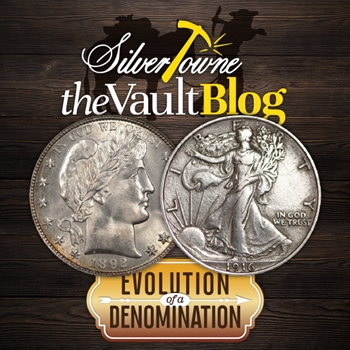
For over half a century, the Liberty Seated half dollar made its run in numismatics and United States coinage. However, as the turn of the century was approaching, the half dollar series, in addition to other denomination coins, needed a serious update. Because half dollars and quarters were not being struck as much during the 1880s, the design remained stagnant as demand waned. The United States Mint knew this and as the 1890s approached and older inventories of the silver coins started to diminish, they finally pulled the trigger and ordered the design change.
Barber or Liberty Head (1892-1915)
In 1890, then Mint Director James P. Kimball asked Congress to pass legislation that would limit coin designs after a minimum of 25 years from that point forward. With that legislation enacted, the half dollar, quarter, and dime were eligible for immediate updating. However, Kimball was entertained at the idea of holding a limited competition to find new designs for the coinage.
Implored by Kimball, the U.S. Treasury invited ten top-notch artists to submit their designs for the half dollar, quarter, and dime. At the top of that list: Augustus Saint-Gaudens. This meant that the contest would in doubt produce some of the most impressive designs, however, the artists selected got together and insisted they would not compete unless a list of terms was agreed upon. Monetary compensation for each sketch in addition to each completed model headed that list of terms. The Treasury did not concede, which opened the competition to the public and around 300 entries to be looked at with none of them meeting the standards needed for such updated coinage.
Ultimately the Chief Engraver of the United States Mint, Charles E. Barber, ended up winning the competition. Barber came up with a similar artwork for all three of the coins that needed updating, including the half dollar. It features a right facing Liberty with her hair wrapped up in a cap with an incused inscription over her brow of ‘LIBERTY.’ The initial ‘B’ for Barber is at the base of her neck with ‘IN GOD WE TRUST’ inscribed at the top of the obverse and the date featured at the bottom. Liberty is surrounded by 13 stars. The reverse features a heraldic eagle clutching an olive branch and a bundle of arrows with ‘UNITED STATES OF AMERICA’ and ‘HALF DOLLAR’ seen inscribed around the outer edges. Mint marks were seen at the bottom of the design as 13 stars were placed above the eagle.
In its debut year (1892), the Barber half dollar was produced at Philadelphia, New Orleans, and San Francisco. A total of 934,000 were produced with 1,245 Proof examples minted. Before the series was over, they were also struck at Denver. Mintages never exceed six million as the highest ever produced came in 1899 with just over 5.5 million struck. Struck for just 24 years, the Mint did not hesitate to change up the design once the minimum of 25 years was over.
Liberty Walking (1916-1947)
As the turn of the century brought forth a number of changes, it was no different with American coinage. While the Barber series, including the half dollar, represented the old, silver coinage was looking towards the new. Once again, the United States Mint was looking for new designs and then Mint Director Robert W. Woolley looked outside the walls of the Mint to do so. He invited three prominent sculptors to put together designs for the three silver coins (half dollar, quarter, dime) in 1915. Those notable sculptors? Hermon A. MacNeil, Albin Polasek, and Adolph A. Weinman. Weinman’s designs ended up on two of the three coins, the dime and half dollar, while MacNeil’s design was featured on the quarter. The Walking Liberty half dollar was born..
In its first year of issue (1916), Walking Liberty half dollars were produced at Philadelphia, Denver, and San Francisco. In the middle of 1917, the Mint decided to move the mint mark, which was previously on the obverse, to the reverse. This produced varieties from both Denver and San Francisco for each mint mark distinction in addition to 1916. Over 485 million coins were struck in the Walking Liberty series between 1916 and 1947, although all throughout the 1920s and early 1930s they were minted sporadically, eventually picking back up annually in 1933.
Although one of most collected United States coins and admired for its incredible design and eye appeal, nothing could keep it from discontinuing in the late 1940s due to weakly struck issues despite a number of modifications made. Key dates include the 1921 P, D, and S as less than 550,000 were produced for each despite over 4.6 million being struck the year before. The 1938-D is also sought after in the series as less than 500,000 were struck.
Source: NGC Coin; The Official 2023 Red Book







